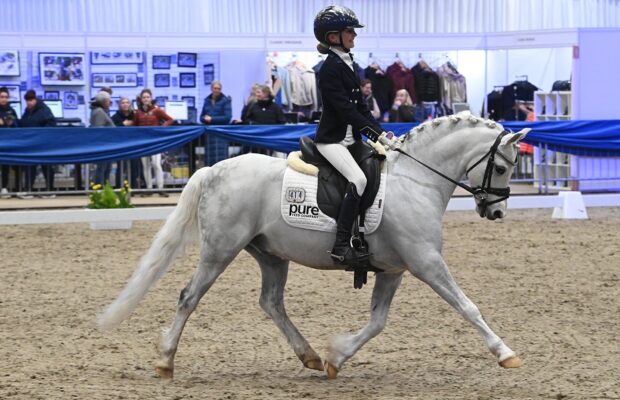Looking for some some new exercises to add to your dressage training at home? Having some new ideas to shake up your schooling is often beneficial for both horse and rider, as it’s easy to get stuck doing the same things day after day.
Luckily the German dressage legend that is Christoph Hess shared plenty of ideas for useful dressage exercises at the 2021 British Dressage National Convention, to revitalise your training regime and help achieve a better way of going from your horse.
1. The one-handed circle
Ride a 15 or 20m circle in either trot or canter, then pop your reins into your outside hand. Let your inside hand drop down by your thigh as you give with your outside hand.
“Many riders use too much inside rein,” explains Christoph, who advises using this exercise at shows before you ride into the arena to help your horse relax. “This helps the horse be in front [of your aids] and opens the frame. Let it happen, and don’t be afraid of the outline changing.
“This is a good dressage exercise to help a horse relax and be supple and it’s good to help the rider be supple and balanced in the saddle.
“The horse may go over the bit, but the suppleness and relaxation will develop. For me, from a scales of training point of view, suppleness is the most important. Without suppleness nothing else works! And happy, relaxed horses are more supple horses.”
2. Transitions on a circle
Canter a 20m circle, then make a transition to trot and ride another circle, before repeating.
Christoph advises shifting your mindset around transitions, so that a canter to trot transition, for example, should not be framed as the end of the canter, but rather, the start of the trot.
“You are not finishing the canter, but starting the trot. Continue to use your driving aids, rather than making the transition with your reins,” he says, explaining that maintaining this forward thinking in your schooling “helps keep horses mentally happy” during their dressage exercises.
3. The light seat
In canter, come into a light seat on the long side, and give and take the reins on a long rein, before riding into a circle and giving and retaking the reins again. Christoph explains that riding in a light seat helps the horse work more over the back, and also develop more natural balance, which will lead to better self-carriage.
“It is important for the horse to be able to produce natural gaits. It is good for riders of all levels to give the back a little more freedom. Giving a longer rein helps a horse use his body and open the body. You should be able to ride a whole test in a light position,” he says.
“Many riders think dressage is just sitting trot, but I think the light seat can also be an important part of a dressage session. The light seat is a position that makes horses happy; it is a welfare position.”
4. The give and retake
Not just that annoying movement in the test; Christoph explains that the simple give and retake of the reins is one of the most useful dressage exercises to use in training.
“We want to always open through the throat-latch, so the horse is always seeking the bit and takes a steady contact,” he says. “Especially in tense horses – don’t be afraid to give that rein. When the horse gets more and more open in the neck and the frame, they can start to swing more over the back.”
5. Holding the saddle
Think the days of holding onto the saddle for balance are behind you? Think again. For Christoph this is a valuable exercise to help improve your sitting trot.
“First of all, never use sitting trot if you don’t already have a good feeling. Use rising trot instead,” advises Christoph. “The best way to learn to sit with the horse’s movement is to use rising trot, then ride a transition from trot to walk. For the last 5-10m go sitting, and put one hand on the saddle so you find balance, while swinging with your pelvis for the last few metres before you come down to walk.”
6. 6-8m circles
To work towards collection while maintaining energy from behind, as well as straightness, Christoph advises riding a 6-8m circle in the corner of the arena, before coming out of it and riding shoulder-in down the long side.
“Collection without impulsion is worthless, and I’ve yet to see a horse at any level who has no issues with straightness,” Christoph points out.
You may also be interested in…

How to stop your horse rushing — and other training gems from Laura Tomlinson
Olympic gold medallist Laura Tomlinson shares some invaluable training tips and tricks to incorporate into your own schooling

8 training gems from Carl Hester that could transform your dressage scores

The scales of training explained for horse riders of all levels

How to teach a horse extended trot – and other training tips from Anna Ross

Subscribe to Horse & Hound magazine today – and enjoy unlimited website access all year round
Horse & Hound magazine, out every Thursday, is packed with all the latest news and reports, as well as interviews, specials, nostalgia, vet and training advice. Find how you can enjoy the magazine delivered to your door every week, plus options to upgrade your subscription to access our online service that brings you breaking news and reports as well as other benefits.




